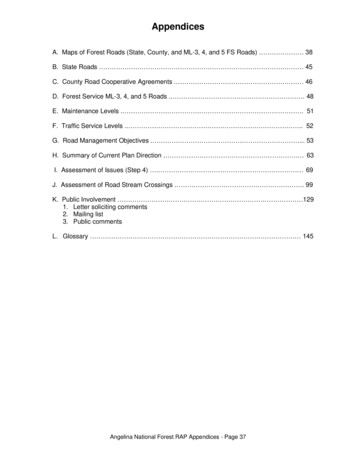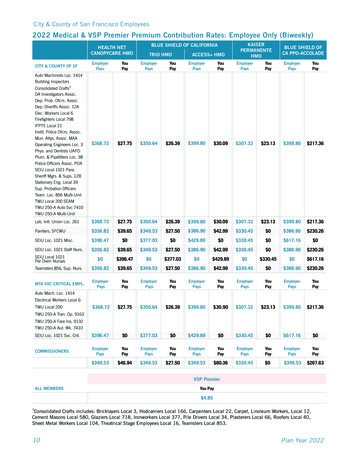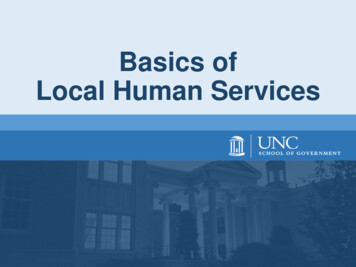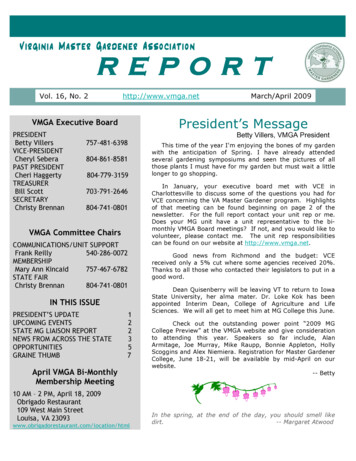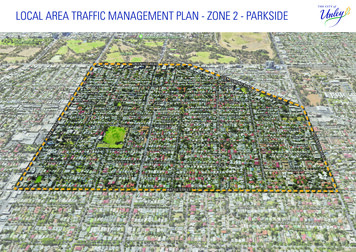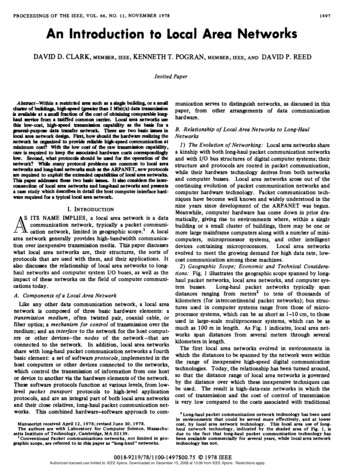
Transcription
PROCEEDINGS OF THEIEEE,VOL.66, NO. 1 1 , NOVEMBER 19781497An Introduction to Local Area NetworksDAVID D. CLARK, MEMBER, IEEE, KENNETH T.POGRAN, MEMBER, IEEE, AND DAVID p. W E DInvited PaperA-t-Within8 msbicled Per SUCh 8S 8 &I&buildin& or 8 munication serves to distinguish networks, as discussed in thispaper, from otherarrangementsof tob coarp loaghardware.holaervicefranrta iffedcanmonctrdet. . CSprLOcrlare81letwmksusebiliv 8S the bgis for 8this low-cor high-apeed t&pneral-purpaedata M e r netwak. There .re two basic issues m B. Relationship of Local Area Networks to Long-Haulloal area netwak desi@. F i t , how should the hadware R.lizingthe N e t w o r knetwak be orgmized to provi& m h b k high-speedcanmuuiatim at W I l Wyi t h! t h e h W C d o f t h e n W h # U t D 8 b i l i t y , I ) The Evolution o f Networking: Local area networks sharecare is required to keep #e amdated hardware c a t s d i n g l y a kinship with both long-haul packet communication networkslow. Secand, A t protocols should be w d fa the apemt anof the and with 1/0 bus structures of digital computer systems; theirw t w a k ? While mrny protocd probkm6 are wmmm to leal -8structure and protocols are rooted in packet communication,netwadrs d loaghmlnetwortr atcb as the ARPANET,new protocds8re requid to explat the extended clprbilitier of leal area network while their hardware technology derives from both networksarea networks arose out of theThbpipaddrerrer&edetWobrdcirrpea ItduoctxMi&athem0er- and computer busses.Localcontinuing evolution of packet communication networks andcainectioa of loal area netwaka and l o n g 4 d netwab rnd plgenk8c.& study which d e s c r i i m detail the host computer interfice h d - computer hardware technology. Packet communication techware required for a typid locd are8 networtniques have become well known and widely understood in thenine years since developmentofthe ARPANETwasbegun.I. INTRODUCTIONMeanwhile, computer hardware has come down in price draS ITS NAME IMPLIES, alocal area network is adata matically, giving rise to environments where, within a sin&communication network, typically a packet communibuilding or a small cluster of buildings, there may be one orcation network, limited in geographic scope.’ A local more large mainframe computers along with a numberof miniarea network generally provides high-bandwidth communica- computers, microprocessor systems, andotherintelligenttion over inexpensive transmission media. This paper discusses devices containing microprocessors. Local areanetworkswhat local area networksare,theirstructures,thesorts of evolved to meet the growing demand for high data rate, lowprotocols that are used with them, and their applications. It cost communication among these machines.also discusses the relationship of local area networks to long2 ) Geographic Scope;Economic and TechnicalConsiderahaul networks and computer system 1 / 0 buses, as well as the tions: Fig. 1 illustrates the geographic scope spanned by longimpact of these networks on the field of computer communi- haul packet networks, local area networks, and computer syscations today.tem busses.Long-haulpacketnetworkstypically spandistances ranging from meters’ to tens of thousands ofA . Components of a Local Area Networkkilometers (for intercontinental packet networks);bus strucLike any other data communication network, a localarea tures used in computer systems range from those of micronetwork is composed of three basic hardwareelements:aprocessor systems, which can be as short as 1-10 cm, to thosetransmission medium, oftentwistedpair,coaxial cable, orused in large-scale multiprocessorsystems, which can be asfiber optics; a mechanism for control of transmission over themuch as 100 m in length. As Fig. 1 indicates, local area netmedium; and an interface to the network for the host computworks span distancesfrom several metersthrough severalers or other devices-the nodes of thenetwork-thatarekilometers in length.connected to thenetwork.Inaddition,localarea networksThe firstlocal area networks evolved inenvironmentsinshare with long-haul packet communication networks afourthbasic element: a set of software protocob, implemented in the which the distances t o be spanned by the network were withinhost computers or other devices connected to the networks, the.range of inexpensive high-speed digital communicationwhich control the transmission of information from one host technologies. Today, the relationship has been turned around,or device to another via the hardware elementsof the network. so that the distance range of local area networks is governedThese software protocols function at various levels, from low- by the distance over which these inexpensive techniques canlevel packettrtlnsportprotocols to high-level application be used. The result is high-data-rate networks in which theprotocols, and are an integral part of both local area networks cost of transmission and the cost of control of transmissionis very low compared to the costs associated with traditionaland their close relatives, long-haul packet communication networks. This combined hardware-software approach t o com’Long-haul packet communication network technology has been usedAManuscript received April 12,1978;revised June 30,1978.The authors are with Laboratory for Computer Science, Massachus e p Institute of Technology, Cambridge, M A 02 139.Conventional Packet communications networks, not limited in geographic scope, are referred t o in this paper as “long-haul” networks.in environments that could be served more effectively, and at Lowercost, by local area networktechnology. This local area use of longhaul network technology, indicated by the shaded area of Fig. 1, isdue to the fact that long-haul packet communication technology hasbeen available commercially for several years, while local area networktechnology has not.0018-9219/78/1100-1497 00.7S 0 1978 IEEEAuthorized licensed use limited to: IEEE Xplore. Downloaded on December 15, 2008 at 13:06 from IEEE Xplore. Restrictions apply.
PROCEEDINGS OF THE IEEE, VOL. 6 6 , NO. 11, NOVEMBER 19781498Local Area Networks I/D BussesComputer SystemI16-4Iob1I.&d.1IIIIIIIbIdolobo164IkmFig. 1. Geographicrange of computer communication networks and1 / 0 buses. The shadedarea of the long-haul network bar indicatesthe distance range for whichthat technology has been used in the past,but which could be better served, in both cost and performance, byemerging local area network technology.data communication networks, providing some unique opportunities conventional longhaul networks do notafford.For long-haul networks, the cost of communication is high.Wide-band common carrier circuits, satellite circuits, andprivatemicrowavelinks are expensive. Longhaul yexpensive(i.e.,50 000-dollar)minicomputersas packetswitches to manage and route traffic flow to make the mosteffective use of the network communication links, delivery ofpackets t o their proper destinations. Thegeographic characteristics of local area networks yield economic and technological considerations that are quite different. Inexpensive,privately owned transmissionmedia can be used. For example,simple twisted pair can support point-topoint communicationin the 1-10-Mbit/srangeoverdistances ontheorderof akilometer between repeaters. Coaxial cable, such as low-lossCATV cable, can support either point-to-point or broadcastcommunication at similardata rates over comparable distances.Typically, base-bandsignaling is used to place digital signalsdirectly on the medium, rather thanby modulation of a carrier.Because the hardware needed to drive and control these transmission media is inexpensive, there is little motivation or needto employ computing power to make the most effective use ofthe available bandwidth. On the contrary,it is quite reasonable to provide additional bandwidth, or to use a greater fraction of the existing bandwidth, if by doing so some other network cost-either hardware or software-can be reduced.3 ) New Opportunities: The economicand technical characteristics of local area networks engendernew applications ofnetworking techniques and provide some unique opportunitiesto simplify traditional networking problems. Many of the constraints that lon&haul networks impose on models of communication over a computer network are not present in localarea networks. One example is broadcastcommunication,such as that used in the Distributed Computer System developed at the University of California at Imine [ 11 .The high-bandwidth and .low-delay attributes of local areanetworksmake possible distributed multiprocessorsystemsutilizing the sort of information sharing between emssharingprimarymemory. Localarea networks canalsobeusedtoprovide a central fide system for a group of small computerswhich do not have their own secondary storage; it is evenpossible to use such a central file system, accessedover thelocal areanetwork,forswappingor paging-an applicationmade especially attractive by the fact that the costof localarea network interface hardware for a typical minicomputercan beless thanthecostof a”floppydisk”driveand itsassociated controller.The high bandwidth of local area networks can be exploitedto simplify the control structure of communication protocolsby removing any motivation to minimize the lengthof controlor overhead information in a packet. Fields of packet headersin local area networks can be arranged to simplify the processinginvolvedincreating or interpreting the packetheader,using as many bits as are necessary. There is little need t o use“shorthand” techniques often found in the protocols of longhaul networks which necessitate additional table lookups bythe receiver of a message. Simplicity also extends to otheraspects of local area network protocols, such as schemes forallocation of network bandwidth, flow control, and error detection and correction.It should be emphasized that local area networks are notan off-the-shelf, plug-in panacea for all local area computercommunication needs. For the distance range over which theyoperate, the technology of local area networksholdsthepromise of doing forcomputercommunicationswhat thehardwareinnovations of the last five years have done forcomputingpower:theycan bringdownthecost of highbandwidth communication andmake possible newapplications.But they cannot by themselves solve the “software problem,’’for with low-cost hardware, thecosts of software developmentwill dominate the cost of any system development using localarea network technology.C. Interconnection with Other NetworksWhile some local area networks nowinuse or under construction are “stand-alone” networks, not connected to othernetworks, the trendis toward interconnection of local areanetworks withlong-haul networks.Interconnection can be motivated either by economics orsimply by the needs of users of the hosts of a local area network. For example, a local area network can provide an economical means of connecting a numberof hosts within asmallarea to one or more long-haul packet networks. The savingsthus obtained is most obvious in the situation where a numberof local host computers are to be connected to more than onelong-haul network; each computer, rather than being directlyconnected to every network (an “M-by-N problem”; see Fig.2(a)), can be connected only to the local area network, andone host (called the gateway) can be Connected between thelocal area network and each of the long-haul networks (Fig.ab)). This cost savings can be worthwhile even in a situationin which local hosts are to be connected only to a single longhaul network, for two reasons; first, hostinterface hardwarefor local area networkscan be lessexpensive than that forlong-haul networks;and,second,onlyasingle port to thelonghaul network, rather than one port for each local host, isrequired.Examples of motivation for interconnection based on users’needs are as follows.a) A computer-based mail system,inwhichmessages toand from users of the several hosts of a local area network canbe exchanged via a long-haul network.b) Access to specialized computing resources, occasionallyrequired by the hosts of a local area network but too expensiveAuthorized licensed use limited to: IEEE Xplore. Downloaded on December 15, 2008 at 13:06 from IEEE Xplore. Restrictions apply.
CLARK etLOCALal.: AN INTRODUCTIONTOAREA NETWORKS1499connecting together the components of a single computer system;it is difficult to imagine a computer continuing t o perNetwork 2form any sort of useful action in the absence of its bus. Incontrast, a network is understood t o connect together a number of autonomous nodes, each capable of operating by itselfin the absence of the network.I ) Defensiveness: This philosophical distinction manifestsitself in the management and control strategies of a network,which are far more defensive than the equivalent strategies of a(a)bus are required to be. For example, the reliability issues surrounding a bus are somewhat differentfrom those surroundinga local area network. While both should be reliable, it is usuallynot critical that a bus continue to work if one if one of thedevices attached to ithas failed;it is usually acceptable to havethe system halt momentarily until the failingdevice can bemanually disconnected from the bus. In contrast, it is presumed that a network will continue to operate despite arbitraryfailures of one or more nodes.The handling of traffic overloads is another example of thedefensive nature of a network. One must anticipate, whendesigning a network, that independently initiated transfers will-Networkoccasionally demand more bandwidth than the network hasavailable, at which time the network itself must mediate gracefully between these conflicting demands. There is usually nosuch concern for a computer bus. The problem of insufficientcapacity on a computer bus t o transfer all the information re(b)Fig. 2. The “M X N Problem” and a local area network as one solutionquired is generally solved by reconfiguration of the hardwareto it. In (a), each of three hosts at a particular site is t o be connectedof the system, or through useof a different programmingto three long-haul networks; each host must implement thecomstrategy.munication protocols for, and be equipped with a hardware interfaceto, all three networks; there may be nine different interfaces and nine2 ) Generality: The intended generality of a computer busprotocol implementations in all. In (b) each host needs onlyoneand a network is a second philosophical distinction betweenhardware interface and oneprotocolimplementation;thegatewaythe two. For example, the protocols that control communicamachines each handle communication between one long-haul networkand the local area network.tion on a local area network are often designed with the explicit intention thatmessages can be exchanged between a localto maintain locally; they can be accessed by users of local area network and a long-haul network, an idea that is usually missingnetwork hostson a fee-for-service basisvia a long-haul network. from the addressing and control structure of a computer bus.c) Communication between local area networks maintained For another example, networks usually transmit variable sizeby a company at each of its maor locations.messages, while buses often transfer single, fixed-size words.The interconnection of a local area network t o a long-haulAnother sort of generality that serves to distinguish a busnetwork presents problems, as well as benefits. At some point, from a network is the nature of the interface that each providesthe protocols used within the local area network must be made to the nodes attached t o it. A computer bus often has a specompatible with those of the long-haul network(s). Compati- cialized interface, oriented towards the addressing and controlbility can be achieved either by adopting the protocols of a architecture of a particular computer. A network, on the otherlong-haul network for thelocal area network, or by performing hand, usually attempts t o provide an interface equally suitableappropriate protocol transformation on messages as they pass for a wide variety of computers and other devices. In this rethrough the gateway. Care must be taken with the former ap- spect, the interface is often less efficient than a bus interface,proach t o ensure that needed capabilities of the local area net- but is easier t o implement for arbitrary devices. Fraser dework are not sacrificed for the sake of ease‘ of the network in- scribes one plausible specification for a general network interterconnection. These issues are discussed in greater detail in face [ 21.Section VI of this paper.3 ) Minor Distinctions: Current realizations of networks andbusses suggest other differences which are much less relevant.11. WHY ISN’T A LQCAL AREANETWORKMERELY ABusses are often even more “local” than our definition of a“BIG Bus”?localarea network. A computer bus is often highlyparallel,A . Distinctions Between Local Area Networks and Computer with separate control, data, and address lines; networks tendBussest o carry this information serially over a single set of lines. OnOne distinguishing feature of local area networks is the geo- the other hand, the idea of a computer bus which is completelygraphic restrictions that permit them to utilize low-cost but serial is veryattractive in the design of microprocessor systems,very high-bandwidth transmission media. That characterization both t o reduce component pinout and to eliminate problemscan also apply to thebus structure of a computer. How, then, of skew on parallel lines.is a local area network different froma “big bus”? The signifi- B. The IEEE Instrumentation Bus as a Border-Line &secant differences are not, as one might initially expect, topologThe IEEE Instrumentation Bus [31 is a good example of aical, technological, or geographic. Rather, the distinction is a communication medium that lies on the boundary between aphilosophical one. A computer bus is usuallyconceived as network and a bus. In certain respects, this bus resembles aAuthorized licensed use limited to: IEEE Xplore. Downloaded on December 15, 2008 at 13:06 from IEEE Xplore. Restrictions apply.
PROCEEDINGSVOL. IEEE,OF THE150066, NO. 11, NOVEMBER 1978local area network, since it has a general interface capable ofNodeinterconnecting a variety of instruments and computers, eachof which operates with a certain degree of autonomy. Philosophically, however, the Instrumentation Bus is indeed verymuch a bus,since its specification is clearlybased ontheassumption that all of the devices connected to a particularbusare intended to operate harmoniously as one system toperform asingle experiment underthe control of one particularexperimenter. The experimenter, not the busitself, is expectedto ensure that the capacity of the bus is not exceeded, and todetect and remove failing nodes which disable the bus. Also,the addressingstructure of the InstrumentationBus, as defined,is not extendable, so that the idea of connecting several ofthese busses together to make a larger network is difficult torealize. This limitation on addressing may prove a hindranceFig. 3. Unconstrained topology. Each node receiving a message mustto experimenters who wish to use the Instrumentation Bus asmake a routing decision t o forward the packet to its fmal deatination.a component of a larger interconnected array of computersand experimental equipment.111. TOFQLOGIESAND CONTROLSTRUCTURESFORLOCAL AREANETWORKSThe introduction of this paper identified three hardwarecomponents of a local area network: the transmission medium,a mechanism forcontrol,andan interface to thenetwork.This section will discuss the first two of these, which togetherprovide the lowest-level functionality of thenetwork,theability to movemessages from place to placein a regulatedmanner.A . Network TopologyNetworktopology is thepattern of interconnection usedamong the various nodes of the network. The mostgeneraltopology is an unconstrained graph structure,withnodesconnectedtogether inan arbitrary pattern, as illustrated inFig. 3. This general structure is the one normally is thatthearrangement of the communication links can be based on thenetwork traffic. This generality is a tool for optimizing theuse of costly transmission media,an idea which is not germaneto local area networks. Further, this generality introduces theunavoidable cost of making a routing decision at each node amessagetraverses.A messagearriving ata nodecannot beblindly transmitted out of all the other linksconnected to thatnode, for that would result in a message that multiplied at everynode and propagated forever in the network. Thus each nodemust decide, as it receives a message, on which link it is to beforwarded, which implies a substantial computation at everynode. Since this general topology is of no significant advantage in a local area network, and does imply a degree of complexity at every node, local area network designers have identified a variety of constrainedtopologieswithattributesparticularly suited to local area networks. We shall considerthree such topologies: the star, the ring, and the bus.1 ) The Stm Network: A star network, illustrated in Fig.*a), elimiaatestheneedfor eachnetworknodeto makerouting decisionsbylocalizingall message routing in onecentral node.Thisleads to a particularly simple structurefor each of theothernetworknodes.Thistopologyis anobviouschoice if thenormal pattern of communication inthe network conforms to its physical topology, with a numberof secondary nodes communicating with one primary node.Forexample,thestar is an obvioustopology to supportanumber of terminals communicating with a time-sharing sys-Fig. 4. Examples of constrained topologies. (a) The star. (b) The ring.(c) The bus.tem, in which case the central node might be the time-sharingmachine itself.If, however,thenormal pattern of communication is notbetween one primary node and several secondary nodes, but isinstead more general communication among all of the nodes,then reliability appears as a possible disadvantage of the starnet. Clearly, theoperation of thenetworkdependsonthecorrect operation of the centralnode,which performsall of therouting functions, and must have capacity sufficient to copewith all simultaneousconversations.Forthesereasons, thecentral node may be a fairly large computer. The cost and difficulty of making the central node sufficiently reliablemaymore than offset any benefit derived from the simplicity ofthe othernodes.2 ) Ring and Bus Networks: The ring andbustopologiesattempt to eliminate the central node on the network, withoutsacrificing the simplicity of the other nodes. While the elimination of the central node does imply acertain complexity atthe other nodes of the net, a decentralized network can beconstructed with a surprisingly simple structure of the nodes.In the ring topology, illustrated in Fig. 4(b), amessage is passedfrom node to node along unidirectional links. There are noAuthorized licensed use limited to: IEEE Xplore. Downloaded on December 15, 2008 at 13:06 from IEEE Xplore. Restrictions apply.
CLARK e t LOCALal.: AN INTRODUCTIONTOAREA NETWORKS1501and back into its shift register. At the moment when the message is again contained in the register, both message and register can be simultaneously removed from the network. If thistechnique is not used, or if the message is damaged and doesnot return intact back to its original sender, it is necessary towait forthenetworkto become idle before removing thebuffer from the network.Theperformancecharacteristicsof the register insertiontechnique are ratherdifferentfromthoseof the previouslydiscussed techniques, since thetotal delay encounteredinthenetworkis variable, and dependsonthenumberofmessages currently being sentaroundthenet.Further,amessage to be sent is inserted in front of, rather than behind,B. Network Control Structuresa message arriving at a node. One analysis [ 81 indicates thatthe register insertionnetworkmay,undercertaincircumBoththe ring networkandthebusnetworkintroduceaproblem, not immediately apparent in the star net,of deter- stances, have better delay andchannelutilizationcharacmining which node may transmit at any given time. The teristics than either the control token ormessage slot strategy.mechanism for control, the second component of the network The register insertion strategy is complex, however, especiallyas listed intheintroduction,performsthis determination. in the technique for removing the register from the networkThis task is not difficult in the star network; either the central when the transmitted message does not return.The register insertiontechnique was initially described bynode has sufficientcapacity to handlea message for everynode simultaneously, or it may poll each of the other nodes in Hanfer et al. [91, in a paper that discusses a variety of operating modes that can be achieved using this technique. In theturn to determine if that node wishes to transmit. Both thering and the bus topology, lacking any central node, must use initial description of the Cambridge Network [ 101 , registersome distributed mechanism t o determine which node may use insertion was proposed as a controlstrategy, because it ensuredafair share allocation of networkbandwidth. Since anodethe transmission medium at any given moment.1 ) DaisyChain,ControlToken, and Message Slots: There that has transmitted one message cannottransmita secondare a varietyof control strategies suitablefor the ring topology, until the first message has passed completely around the ring,basedon the general idea that permission to use the net is and the node has removed its register from the network, everypassed sequentiallyaroundthe ring fromnode to node. In other node has a chance to send one message before a givenwhat is often called a daisy chain network, dedicated wires are node may transmita second. However, circulating messageused to pass the control information from one node t o the slots were finally chosen as thecontrol mechanismof thenext. Alternatively, the control information may be a special Cambridge Network. Slots, if suitably employed, ensure fairbit pattern transmitted over the regular data channel of the share allocation, and the slot mechanism reduces the numberring. For example, the network for the Distributed Computing of components whose failure can disrupt network operation,System uses an 8-bit control token that is passed sequentially since there is no buffer in series with the net. Thus the slotaroundthe ring [41. Any node,upon receiving thecontrolscheme seemed more reliable. The register insertion techniquetoken, may remove the token from the ring, send a message, is currently being usedas the control strategy in the Distributedand then pass on the control token. A third strategy for ring Loop ComputingNetwork (DLCN) described by Liu andcontrol is to continually transmit around the network a series Reames [ l l l .3 ) Contention Control: A bus topology also requires a deof message slots, sequences of bits sufficient to hold a fullcentralized control strategy. One very simple control strategymessage. A slot may be empty or full, and anynode,onnoticing an empty slot passing by, may mark the slot as full that has been used for bus networks is contention. In a conand place a message init.Thisstrategywas described by tention net, any node wishing to transmit simplydoes so.Pierce [ 51, and has been used in the Cambridge Net [6] and Since thereis no control or priority,nothingpreventstwoin the network described by Zafiropulo and Rothauser [ 71. nodes from attempting to transmit simultaneously, inwhichThis technique is not completely decentralized,since one node case a collision occurs, and both messages are garbled andpresumably lost. The contentioncontrolstrategydependsmust initially generate the slot pattern.on the ability of a node to detect a collision, at which point2 ) Register Insertion: Another control strategy particularlysuited for the ring topology is called register insertion. In this it waits a random amount of time (so that the same collisionit message.Assumingtechnique, a message to be transmitted is first loaded into a wiU not recur),andtkenretransmitsshift register. The network loop is then broken and this shift that networktraffic on the average consumes onlya smallregister inserted in the net, eitherwhen the net is idle or at the percentage of the available bandwidth,thenumber of collipoint between two adjacent messages. The message to be sent sions and retransmissions will be reasonably small. The essenis thenshifted out onto thenet while any message arriving tial local area network characteristic of inexpensive bandwidthduring this period is shifted into the register behind the mes- makes this strategy well suited to a local network. The bandsage being sent. Since the shift register has then become an width wasted in order to keep the channel utilization low is aactive component of the network, no further messages can be small price to pay in return for the very simple mechanismssent by this node until the register is switched back out of the that must be implemented at each node: a timer capable ofring. This can only be done at amoment when there is no generating a random distribution,and some means of detectinguseful messagz inthe register. One obvious way to remove collisions.A variety of strategies havebeenused to detect collisions.the register from the network is to allow the message transThe first use of a contention packet networkwas the ALOHAmitted by the node to pass all the way around the networkrouting decisions to be ma
cost, by local area network technology. This local area use of long- due to the fact that long-haul packet communication technology has haul network technology, indicated by the shaded area of Fig. 1, is been available commercially for several years, while local area network technology has not.
